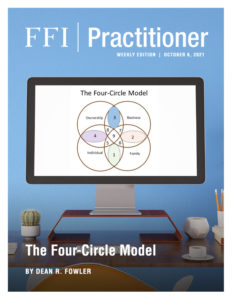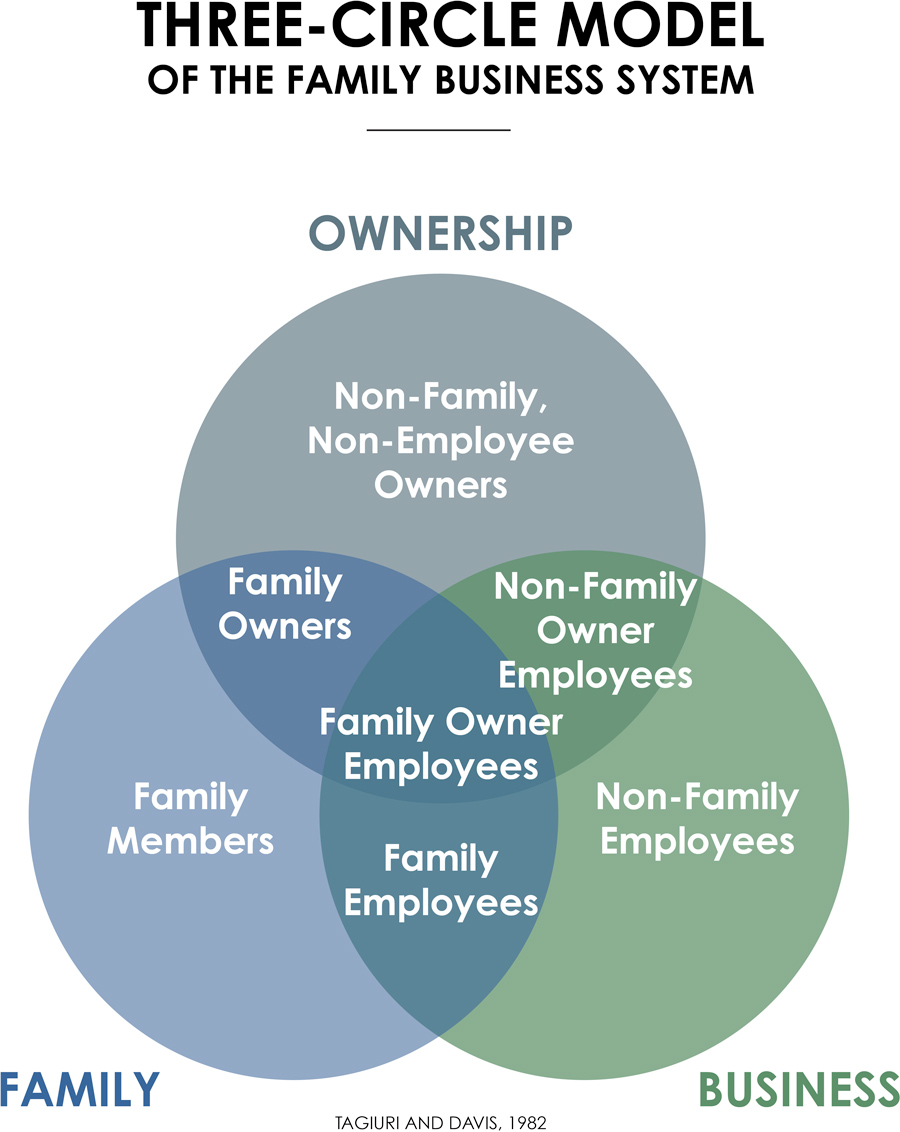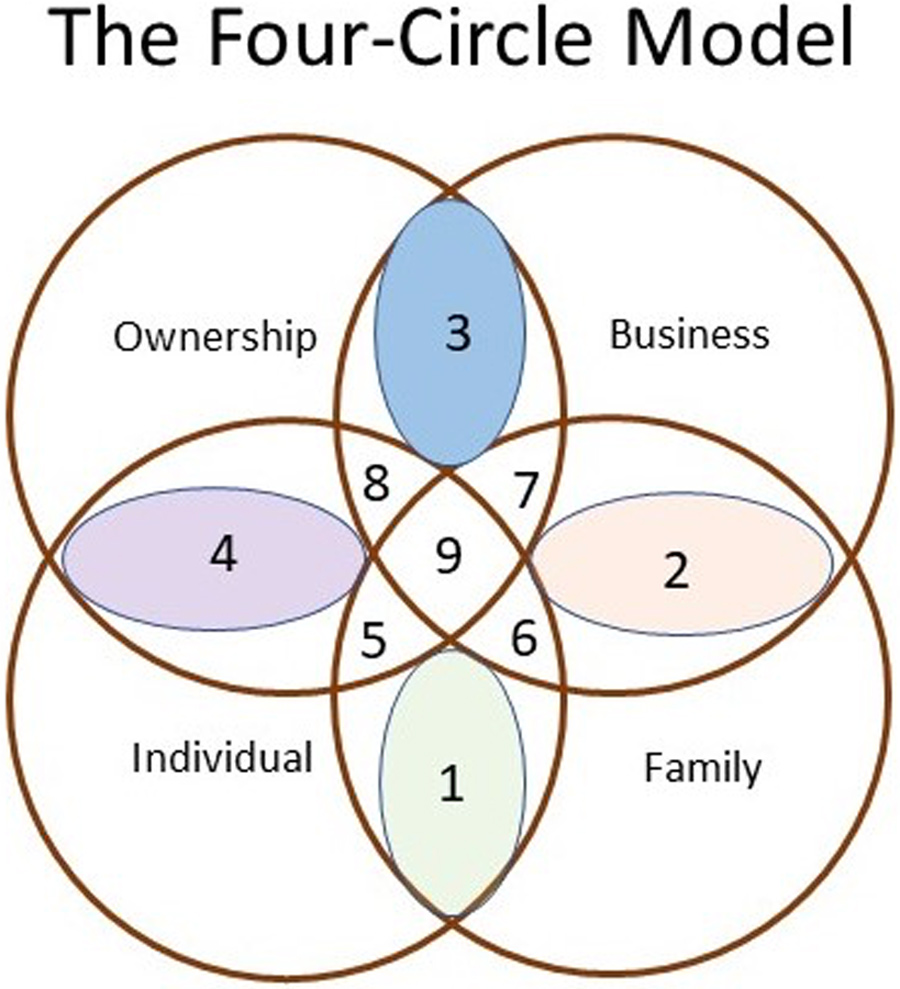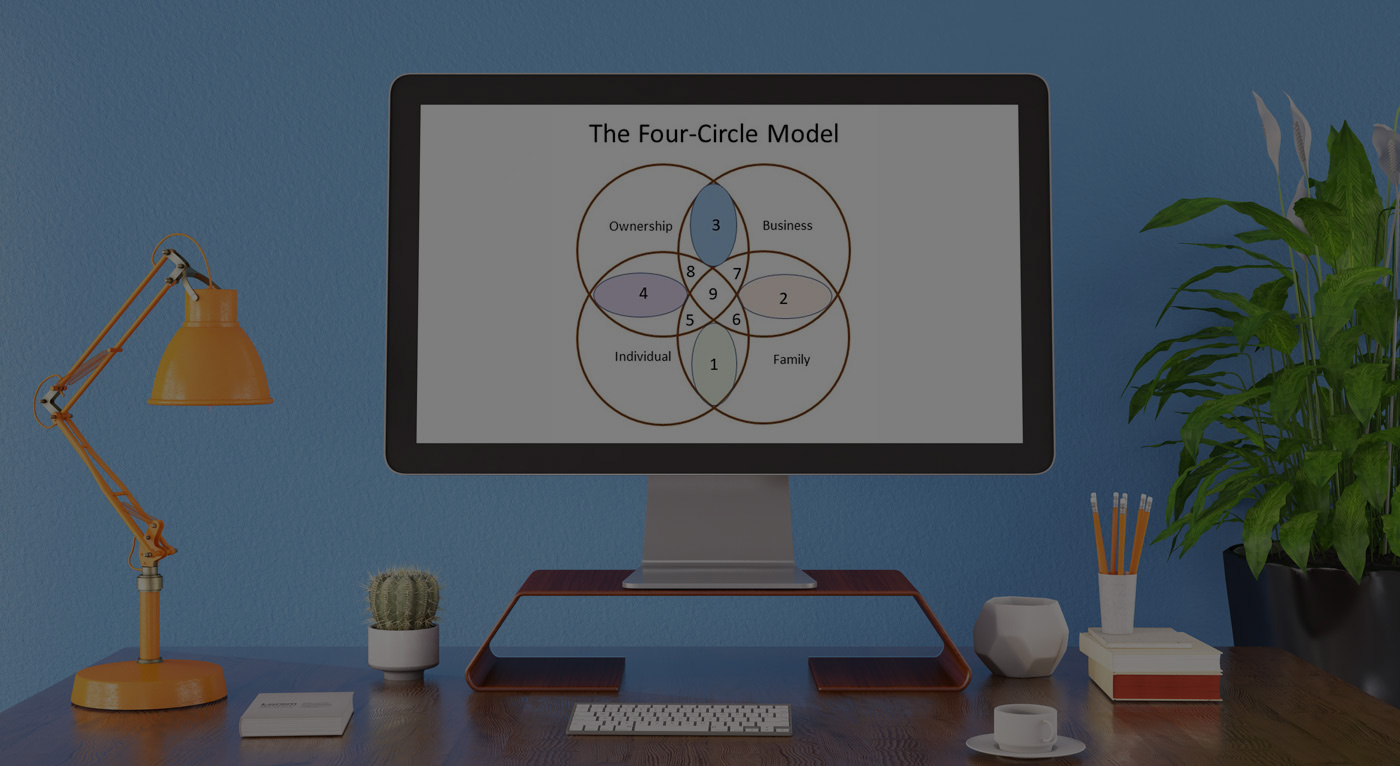
View this edition in our enhanced digital edition format with supporting visual insight and information.
Thanks to this week’s contributor and FFI Fellow, Dean Fowler, for providing an overview of his Four-Circle Model. In the article, Dean explains how his model builds upon the Three-Circle Model and can be utilized by advisors to help understand and map the role of individuals in the system and their relationship to their family.
Over the past forty years, two themes have been critical for shaping consulting with family businesses: first, a systemic approach, and second – in more recent years – the inclusion of the next generation in transition planning. In this article, I discuss my Four-Circle Model for consulting with family enterprises that is both systemic and honors the next generation as individuated adults. My purpose is not to critique the more well-known Three-Circle Model, but rather to offer a proposed enhancement to the systemic approach for understanding families in business and families of wealth.
Prof. John Davis is a pioneer in the field of family business. The main purpose for developing his original Three-Circle Model was to identify the distinct roles held in the family business and how those roles shape individual perspectives. For more than 40 years, numerous consultants and researchers have used the systemic approach described by the Davis-Taguri model to explore a broad range of other topics as well.

The celebration of the 40th anniversary of the Three-Circle Model was explored in depth in two issues of the FFI Practitioner (see the sidebar for the two interviews with John Davis).
On the one hand, models, theories, and paradigms are powerful tools to focus our attention when studying a given discipline. On the other hand, models may also limit the questions we ask, the topics we explore, and our understanding of critical issues.1 My Four-Circle Model focuses attention on the role of individual adults in relationship to their own family of origin and broadens the systemic approach to working with and studying business families.
In the 1980s, when FFI was first holding national conferences, I presented my Four-Circle Model for studying families in business at several workshops. After discussing my model and research ideas with the Psycho-Dynamic Family Business group (PDFB) in 1993, I was encouraged to complete research to determine how the Four-Circle Model could be used to identify the most critical competencies that business families had to master for success. That research was published in the proceedings at the 1999 FFI conference.
The Four-Circle Model is different from the Three-Circle Model in four significant ways:
- The addition of the “individual circle” is critical, because in a family-owned business, advisors are often dealing with a family of adults, and healthy adults have typically individuated themselves from their family of origin. Healthy adult families are intentional. In my judgment, intergenerational family therapies, such as those developed by Murray Bowen2 and James Framo,3 are well suited to examine the systemic relationships between adults and their families of origin.
- The model focuses attention on competencies, particularly the competencies that must be mastered at each of the four intersection areas illustrated in the diagram.
- Individuals and/or individual beneficiaries, not families, own family businesses.
- Individuals such as board members and advisors who are not family members fit into the model in Sector 8.

Based on my research, twelve statistically reliable “factors” were identified that represent the competencies that must be mastered by individuals and their families for success:
Competencies of Intersection 1: Between adult individuals and their family of origin
- Maturity – Individuals must separate both emotionally and financially from their family of origin and develop a strong sense of their own self-esteem.
- Purpose – Adults must determine their own purpose by developing and pursuing passions either inside or outside the family business.
- Communication – Families must listen for understanding as well as to be understood and develop strong communication skills.
Competencies of Intersection 2: Between the family and the business
- Roles – Clear guidelines should be established concerning appropriate boundaries between the business and the family, so that roles can be differentiated.
- Business Competency – Business competency deals with developing a broad-based knowledge of the business.
- Compensation – Families must determine how to balance family fairness with the best business practices, based on national and regional compensation plans.
Competencies of Intersection 3: Between the business and ownership
- Strategy – For long-term success across generations, the owners and the business must develop a clear and comprehensive strategy with a mission, vision, and goals for growth.
- Structure – The organizational structure of the business must support the strategy. This requires having the right people in the right roles.
- Leadership – Professionalization of the business may be necessary, perhaps by having qualified family members coupled with a capable non-family executive leadership team.
Competencies of Intersection 4: Between ownership and adult individuals
- Succession – Based on the strategy and structure of the business, the transition of management from one generation to the next is critical. This succession may include next-gen family leaders, or a non-family president/CEO.
- Governance – Either an advisory board or a fiduciary board of directors should be in place for the long-term success of the business.
- Estate Planning – Estate, financial, and tax planning should support rather than drive the other competencies. The ownership transition plan should capture the voice, vision, and values of both the current and next generation shareholders.
The Four-Circle Model and the related twelve competencies from my research have shaped my consulting practice for decades. With an emphasis on adult individuals, and the individuation process, my primary client is the next generation–individuals, siblings, and/or cousins.
The senior generation gives legal permission to their advisors including the attorneys, accountants, insurance, and financial planning professionals to work directly with the successor generation. The next generation of adults then would design the optimal structure for the transition of the business and ownership, so that the business and the family will be setup to thrive in the future. In addition to planning with a team of advisors, the next generation also works on mastering the twelve competencies for future success and the implementation of the recommended structures and policies for the intergenerational transition. The process often takes several years, working interactively through a family or owners council, through which the next generation makes their recommendations to the senior generation, who controls the voting shares for their approval.
Based on my research using the Four-Circle Model, I developed an online assessment process with a questionnaire and report that benchmark how family members, non-family executives, and advisors–from the perspective of different sub-groups (roles ala Davis) –assess how the family is mastering these twelve competencies.4
Notes
1 In his seminal work The Structure of Scientific Revolutions (1970), Thomas Kuhn demonstrated that scientific theories are in fact “paradigms.” From the perspective of the sociology of knowledge, Kuhn argued that scientific communities share a common set of theories and ideas that are excellent tools to explore problems. However, in the history of science, there is a paradigm shift through which new theories emerge – for example from Newtonian physics to Einstein’s theory of relativity. Kuhn’s position contrasts with classical rationalism put forth by Karl Popper.
2 For key principles regarding Bowen read The Eight Concepts of Bowen Theory First Edition by Dr. Roberta M Gilbert or see the website https://www.thebowencenter.org/
3 Family-Of-Origin Therapy: An Intergenerational Approach by James L. Framo
4 This online assessment and questionnaire can be found at (https://www.deanfowler.com)
About the Contributor

Dean R. Fowler, PhD, FFI Fellow has advised business families for 38 years as well as facilitating Forums for Family BusinessTM – peer advisory boards – that specialize in personal and professional development through diversified experiences and accountability, while focusing on successful intergenerational transitions. He is the author of several books, including Love, Power and Money: Family Business between Generations. He can be reached at dean@deanfowler.com.

View this edition in our enhanced digital edition format with supporting visual insight and information.





